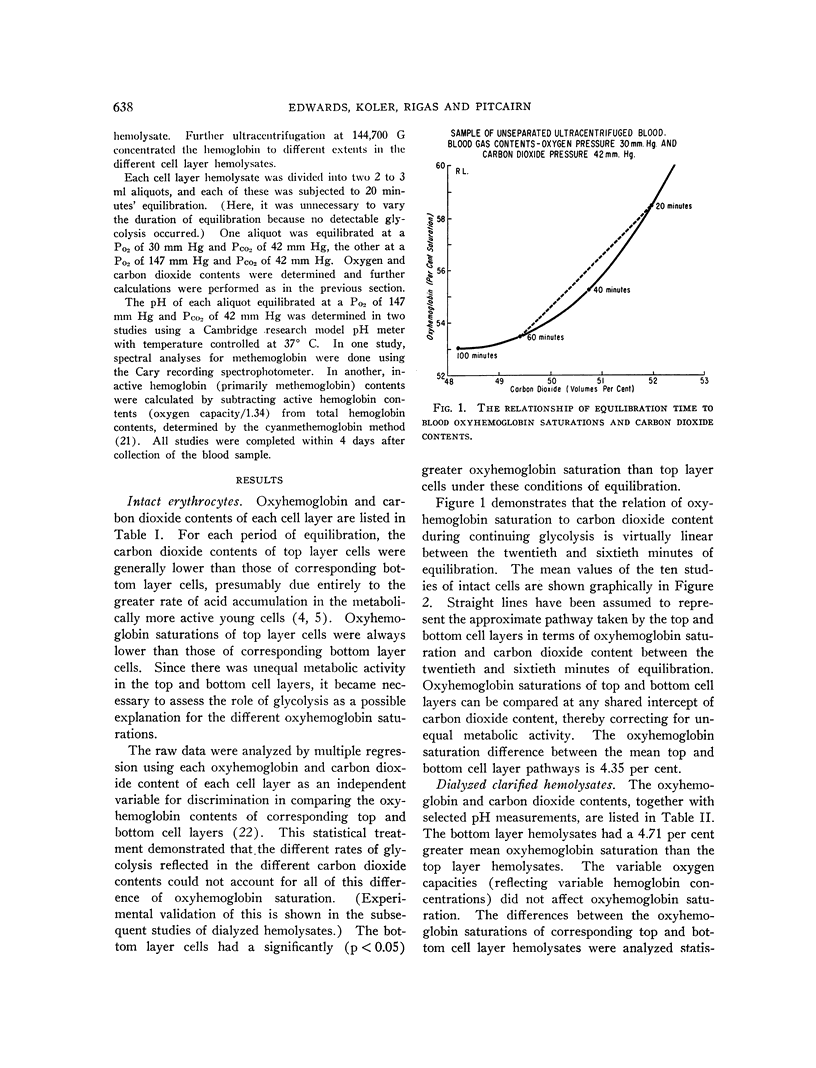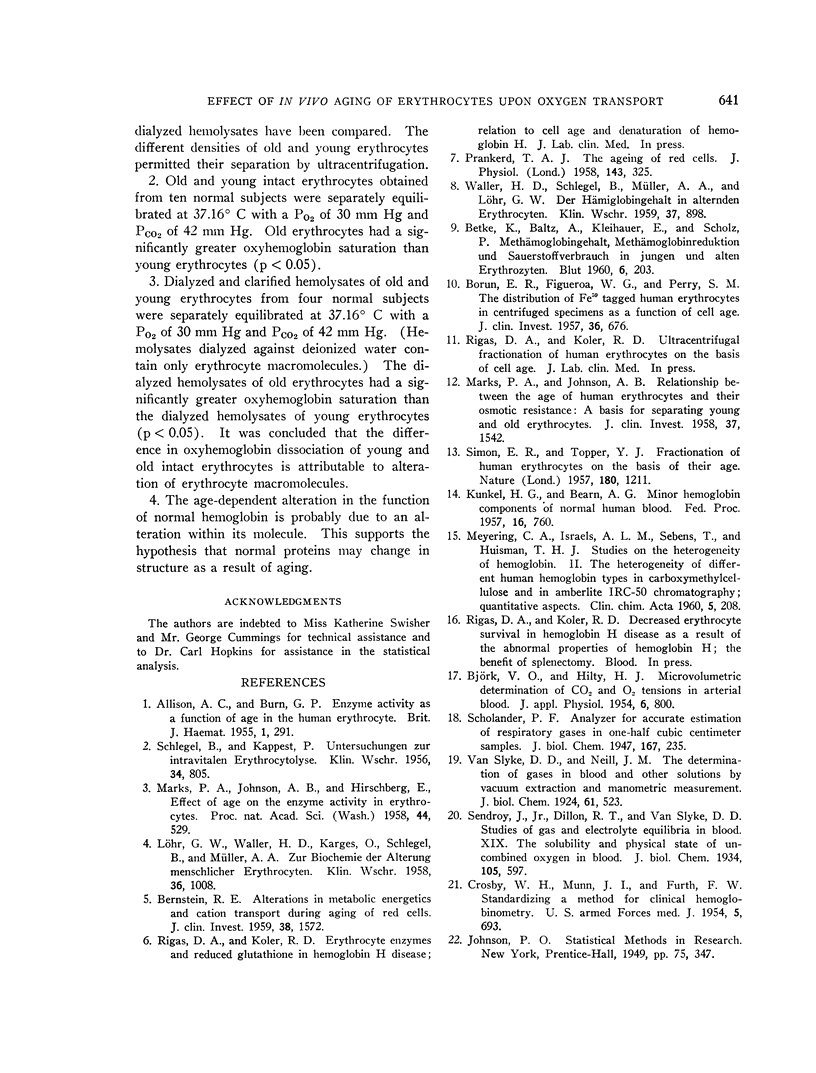Full text
PDF






Selected References
These references are in PubMed. This may not be the complete list of references from this article.
- ALLISON A. C., BURN G. P. Enzyme activity as a function of age in the human erythrocyte. Br J Haematol. 1955 Jul;1(3):291–303. doi: 10.1111/j.1365-2141.1955.tb05511.x. [DOI] [PubMed] [Google Scholar]
- BERNSTEIN R. E. Alterations in metabolic energetics and cation transport during aging of red cells. J Clin Invest. 1959 Sep;38:1572–1586. doi: 10.1172/JCI103936. [DOI] [PMC free article] [PubMed] [Google Scholar]
- BJORK V. O., HILTY H. J. Microvolumetric determination of CO2 and O2 tensions in arterial blood. J Appl Physiol. 1954 Jun;6(12):800–808. doi: 10.1152/jappl.1954.6.12.800. [DOI] [PubMed] [Google Scholar]
- BORUN E. R., FIGUEROA W. G., PERRY S. M. The distribution of Fe59 tagged human erythrocytes in centrifuged specimens as a function of cell age. J Clin Invest. 1957 May;36(5):676–679. doi: 10.1172/JCI103468. [DOI] [PMC free article] [PubMed] [Google Scholar]
- BURKE J. D. The effects of different salt concentrations on the affinity of hemoglobin for oxygen. J Cell Comp Physiol. 1959 Aug;54:126–128. doi: 10.1002/jcp.1030540114. [DOI] [PubMed] [Google Scholar]
- Barcroft J., Bock A. V., Hill A. V., Parsons T. R., Parsons W., Shoji R. On the hydrogen-ion concentration and some related properties of normal human blood. J Physiol. 1922 May 16;56(3-4):157–178. doi: 10.1113/jphysiol.1922.sp001999. [DOI] [PMC free article] [PubMed] [Google Scholar]
- Barcroft J., Camis M. The dissociation curve of blood. J Physiol. 1909 Aug 26;39(2):118–142. doi: 10.1113/jphysiol.1909.sp001330. [DOI] [PMC free article] [PubMed] [Google Scholar]
- CROSBY W. H., MUNN J. I., FURTH F. W. Standardizing a method for clinical hemoglobinometry. U S Armed Forces Med J. 1954 May;5(5):693–703. [PubMed] [Google Scholar]
- HOREJSI J., KOMARKOVA A. The effect of SH-groups on the affinity of haemoglobin to oxygen. Clin Chim Acta. 1958 Mar;3(2):131–136. doi: 10.1016/0009-8981(58)90070-6. [DOI] [PubMed] [Google Scholar]
- HOREJSI J., KOMARKOVA A. The influence of some factors of the red blood cells on the oxygen-binding capacity of haemoglobin. Clin Chim Acta. 1960 May;5:392–395. doi: 10.1016/0009-8981(60)90144-3. [DOI] [PubMed] [Google Scholar]
- KAPPEST P., SCHLEGEL B. Untersuchungen zur intravitalen Erythrocytolyse. Klin Wochenschr. 1956 Aug 1;34(29-30):805–807. doi: 10.1007/BF01468052. [DOI] [PubMed] [Google Scholar]
- KUNKEL H. G., BEARN A. G. Minor hemoglobin components of normal human blood. Fed Proc. 1957 Sep;16(3):760–762. [PubMed] [Google Scholar]
- LOHR G. W., WALLER H. D., KARGES O., SCHLEGEL B., MULLER A. A. Zur Biochemie der Alterung menschlicher Erythrocyten. Klin Wochenschr. 1958 Nov 1;36(21):1008–1013. doi: 10.1007/BF01487970. [DOI] [PubMed] [Google Scholar]
- MARKS P. A., JOHNSON A. B. Relationship between the age of human erythrocytes and their osmotic resistance: a basis for separating young and old erythrocytes. J Clin Invest. 1958 Nov;37(11):1542–1548. doi: 10.1172/JCI103746. [DOI] [PMC free article] [PubMed] [Google Scholar]
- MURAYAMA M. Conformational differences of mercapto groups of four hemoglobins. Fed Proc. 1957 Sep;16(3):756–759. [PubMed] [Google Scholar]
- Marks P. A., Johnson A. B., Hirschberg E. EFFECT OF AGE ON THE ENZYME ACTIVITY IN ERYTHROCYTES. Proc Natl Acad Sci U S A. 1958 Jun;44(6):529–536. doi: 10.1073/pnas.44.6.529. [DOI] [PMC free article] [PubMed] [Google Scholar]
- PRANKERD T. A. The ageing of red cells. J Physiol. 1958 Sep 23;143(2):325–331. doi: 10.1113/jphysiol.1958.sp006062. [DOI] [PMC free article] [PubMed] [Google Scholar]
- Pauling L. The Oxygen Equilibrium of Hemoglobin and Its Structural Interpretation. Proc Natl Acad Sci U S A. 1935 Apr;21(4):186–191. doi: 10.1073/pnas.21.4.186. [DOI] [PMC free article] [PubMed] [Google Scholar]
- RIGAS D. A., KOLER R. D., OSGOOD E. E. Hemoglobin H; clinical, laboratory, and genetic studies of a family with a previously undescribed hemoglobin. J Lab Clin Med. 1956 Jan;47(1):51–64. [PubMed] [Google Scholar]
- RIGGS A. F. Sulfhydryl groups and the interaction between the hemes in hemoglobin. J Gen Physiol. 1952 May;36(1):1–16. doi: 10.1085/jgp.36.1.1. [DOI] [PMC free article] [PubMed] [Google Scholar]
- RIGGS A. F., WOLBACH R. A. Sulfhydryl groups and the structure of hemoglobin. J Gen Physiol. 1956 Mar 20;39(4):585–605. doi: 10.1085/jgp.39.4.585. [DOI] [PMC free article] [PubMed] [Google Scholar]
- SCHLEGEL B. Agglutination der durch Isoantikörper inagglutinablen Erythrocyten mit Hilfe von Phytagglutininen. Klin Wochenschr. 1957 Jul 1;35(13):680–682. doi: 10.1007/BF01481270. [DOI] [PubMed] [Google Scholar]
- SIMON E. R., TOPPER Y. J. Fractionation of human erythrocytes on the basis of their age. Nature. 1957 Nov 30;180(4596):1211–1212. doi: 10.1038/1801211a0. [DOI] [PubMed] [Google Scholar]
- VALTIS D. J., BAIKIE A. G. The influence of red-cell thickness on the oxygen dissociation curve of blood. Br J Haematol. 1955 Apr;1(2):146–154. doi: 10.1111/j.1365-2141.1955.tb05496.x. [DOI] [PubMed] [Google Scholar]
- WALLER H. D., SCHLEGEL B., MUELLER A. A., LOEHR G. W. [Hemoglobin content in aging erythrocytes]. Klin Wochenschr. 1959 Sep 1;37:898–900. doi: 10.1007/BF01478505. [DOI] [PubMed] [Google Scholar]


